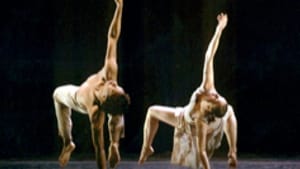Stay in the Loop
BSR publishes on a weekly schedule, with an email newsletter every Wednesday and Thursday morning. There’s no paywall, and subscribing is always free.
A thousand years of tenderness
National Dance Company of Spain 2 at Annenberg (2nd Review)

The Annenberg closed its "Dancemaker" series with the National Dance Company of Spain 2, a junior troupe comprised of 17- to-23-year-olds culled from across the globe. In three works by the company's artistic director Nacho Duato, they executed his modern dance pieces with incredible technical proficiency, but the corps only achieved a fullness of sensibility in one of them.
The sculpture garden of Duato's Duende kicked off the evening with playful, sprightly choreography that leaps and jumps and zings through the air before pausing in still images: layers of bodies resting across one another, prostrate dancers holding one another aloft on outstretched hands, and women splitting their legs mid-lift.
But the first half-dozen segments, featuring solos, duets, and trios, never lived up to a title that connotes that intangible Spanish sense of soul, energy and charm. Nicolas Fischtel's indifferent lighting varied with the shifting emotions of Debussy's music, inhibited further by the youthfulness of dancers not yet able to command the stage with their presence.
Only the final full ensemble movement achieved the requisite sense of life. As the dancers moved seamlessly across the stage, Duende's sensuous flow would suddenly force them all to stop in unison to hold poses, their bodies fluttered like a snapped wire that imperceptibly pauses twice in each cycle of motion.
The heart overrules the head
The company's younger dancers fared better in Duato's Without Words, whose elegiac quality and referenced themes of love and isolation and death allowed them to explore issues presumably closer to their own lives. Here, a daisy chain of paramours— sometimes two men and one woman, at others three men, and always with someone standing isolated at the back of the stage— reveled in Schubert's lush melodies.
Overhead projections displayed close-ups of the dancers' faces, often in repose or longing. Their emotions now reflected the way Duende captured the transient sculptural architecture of overlapping bodies. A scrim enabled a series of near-magical effects, where dancers emerged unseen from the darkness to join others already standing still in file.
Without Words aptly conveyed a sense that the heart reacts before the head— whether to betrayal, loss, jealousy, or love—without any need to verbalize what Duato so easily expressed in movement. But throughout, Without Words blended the sensual and the melodramatic. A man used hands placed on a woman's thighs to move her forward by the crotch; moments later, after being carried aloft (and then choosing between) two men, a woman covered her lover's eyes as the rejected suitor took his place of isolation.
Descendants of Moroccan slaves
Gnawa, Duato's final— and most recent—work of the evening, evoked a much different sensibility from the start. The similar lifts and mid-lift poses of his choreography now raced along as explosive movements, aggressive and searching. Duato muted nothing here, fashioning the entire piece with narrative fragments illustrating a sense of ritual in life.
The title refers to the Gnawa, descendants of former slaves from sub-Saharan Africa who settled in Morocco. Duato says he uses their traditions and music (by many composers) to search "deeper into his roots and those of his predecessors" and "transmit the sensuality of the Mediterranean landscape and the true nature of its people."
Clothed by Luis Devota and Modesto Lomba in long flowing blue dresses (for the women) and patterned silk trousers (for the men), two lines of dancers snaked their way across the stage from the wings, the hands of each gripping the shoulders of the dancer in front of them. In a tight circle under a bright spotlight from above, a pair would throw one woman aloft while the remaining ensemble pulsed like a horde in a side-to-side rhythm. As they thumped their hands against thighs, their collective, anxious trance emanated a terrifying sense of religious fervor.
The feel of a tent in the desert
Later, the women evoked a Bedouin sensibility as they carried circular candle-lit pottery lamps to the lip of the stage, to the sounds of birds chirping and water bubbling. In the non-ensemble interludes, a young woman reclined by a stream as her young lover circled confidently around her. Fischtel's hazy lighting created the feel of watching these allegories from behind sandstone walls or outside a tent in the desert, but I felt no distance of culture or time.
Just as Picasso— another Spaniard— could use a painting to show "a thousand years of tenderness in a woman combing her hair," the fractured story-driven vignettes and music both illuminated the Moroccan culture that influenced Mediterranean (and especially Spanish culture) while touching upon something immutable, universal and pure: In the village of everyone's life there is a river, where a beautiful young person silently kneels down beside it to bathe. â—†
To read another review by Janet Anderson, click here.
The sculpture garden of Duato's Duende kicked off the evening with playful, sprightly choreography that leaps and jumps and zings through the air before pausing in still images: layers of bodies resting across one another, prostrate dancers holding one another aloft on outstretched hands, and women splitting their legs mid-lift.
But the first half-dozen segments, featuring solos, duets, and trios, never lived up to a title that connotes that intangible Spanish sense of soul, energy and charm. Nicolas Fischtel's indifferent lighting varied with the shifting emotions of Debussy's music, inhibited further by the youthfulness of dancers not yet able to command the stage with their presence.
Only the final full ensemble movement achieved the requisite sense of life. As the dancers moved seamlessly across the stage, Duende's sensuous flow would suddenly force them all to stop in unison to hold poses, their bodies fluttered like a snapped wire that imperceptibly pauses twice in each cycle of motion.
The heart overrules the head
The company's younger dancers fared better in Duato's Without Words, whose elegiac quality and referenced themes of love and isolation and death allowed them to explore issues presumably closer to their own lives. Here, a daisy chain of paramours— sometimes two men and one woman, at others three men, and always with someone standing isolated at the back of the stage— reveled in Schubert's lush melodies.
Overhead projections displayed close-ups of the dancers' faces, often in repose or longing. Their emotions now reflected the way Duende captured the transient sculptural architecture of overlapping bodies. A scrim enabled a series of near-magical effects, where dancers emerged unseen from the darkness to join others already standing still in file.
Without Words aptly conveyed a sense that the heart reacts before the head— whether to betrayal, loss, jealousy, or love—without any need to verbalize what Duato so easily expressed in movement. But throughout, Without Words blended the sensual and the melodramatic. A man used hands placed on a woman's thighs to move her forward by the crotch; moments later, after being carried aloft (and then choosing between) two men, a woman covered her lover's eyes as the rejected suitor took his place of isolation.
Descendants of Moroccan slaves
Gnawa, Duato's final— and most recent—work of the evening, evoked a much different sensibility from the start. The similar lifts and mid-lift poses of his choreography now raced along as explosive movements, aggressive and searching. Duato muted nothing here, fashioning the entire piece with narrative fragments illustrating a sense of ritual in life.
The title refers to the Gnawa, descendants of former slaves from sub-Saharan Africa who settled in Morocco. Duato says he uses their traditions and music (by many composers) to search "deeper into his roots and those of his predecessors" and "transmit the sensuality of the Mediterranean landscape and the true nature of its people."
Clothed by Luis Devota and Modesto Lomba in long flowing blue dresses (for the women) and patterned silk trousers (for the men), two lines of dancers snaked their way across the stage from the wings, the hands of each gripping the shoulders of the dancer in front of them. In a tight circle under a bright spotlight from above, a pair would throw one woman aloft while the remaining ensemble pulsed like a horde in a side-to-side rhythm. As they thumped their hands against thighs, their collective, anxious trance emanated a terrifying sense of religious fervor.
The feel of a tent in the desert
Later, the women evoked a Bedouin sensibility as they carried circular candle-lit pottery lamps to the lip of the stage, to the sounds of birds chirping and water bubbling. In the non-ensemble interludes, a young woman reclined by a stream as her young lover circled confidently around her. Fischtel's hazy lighting created the feel of watching these allegories from behind sandstone walls or outside a tent in the desert, but I felt no distance of culture or time.
Just as Picasso— another Spaniard— could use a painting to show "a thousand years of tenderness in a woman combing her hair," the fractured story-driven vignettes and music both illuminated the Moroccan culture that influenced Mediterranean (and especially Spanish culture) while touching upon something immutable, universal and pure: In the village of everyone's life there is a river, where a beautiful young person silently kneels down beside it to bathe. â—†
To read another review by Janet Anderson, click here.
What, When, Where
National Dance Company of Spain 2: Duende, Without Words, Gnawa. Choreography by Nacho Duato. May 14-16, 2009 at Annenberg Center, 3680 Walnut Street. (215) 898-3900 or www.pennpresents.org.
Sign up for our newsletter
All of the week's new articles, all in one place. Sign up for the free weekly BSR newsletters, and don't miss a conversation.

 Jim Rutter
Jim Rutter